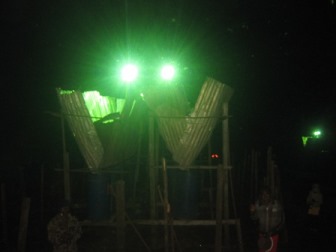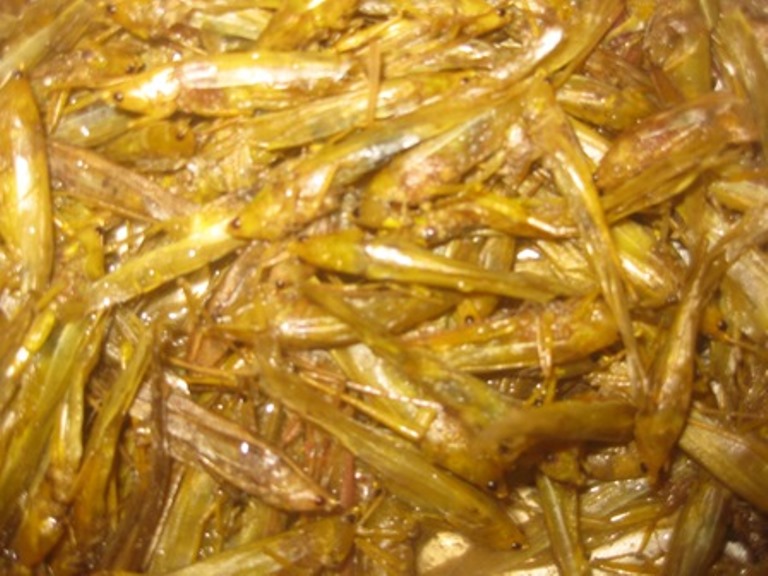"Mungwin season brings risks and delicacies"
November 24th, 2014 Grasshoppers become a lucrative delicacy as Alphonse Akouyu, 20, a Commonwealth Correspondent from Bamenda in Cameroon, learns when he explores the hazards of catching and the tricks of cooking the winged treats.
Grasshoppers become a lucrative delicacy as Alphonse Akouyu, 20, a Commonwealth Correspondent from Bamenda in Cameroon, learns when he explores the hazards of catching and the tricks of cooking the winged treats.
The dry season is already approaching here in Bamenda, Cameroon, and this to some extent signifies the coming of the festive season.
However, there is also the significant presence of grasshoppers, popularly known here as ‘Mungwin’. Mungwin constitute a very tasty delicacy especially when it is fried or cooked depending on the form.
The insect is attracted by white fluorescent bulbs and flies at different angles around the bulbs, where those interested in having a mungwin meal can easily catch and proceed with the next stage of preparation. The mungwin is highly valued here, so much such that people invest in the mungwin business. It now common around streets of the North West Region, especially here in Bambili which is about 12 kilometres from the regional capital, to see what some call mungwin traps.
These are made of white fluorescent bulbs which are attached to sticks. On both sides of the bulb are small sheets of zinc, and beneath are drums or basins. Here is how is the traps works: the insect flies around the bulb and most often lands on the zinc. Because the sheets of zinc are in the form of a slope, it is easy for the precious insect to slide down it in to the drums or basins underneath. The entire process takes place only in the night. The delicacy is highly valued – so much so that people invest huge amounts in the traps. In fact at night, especially where the traps are set up, there are many young people aged 5-18 all wanting to catch these grasshoppers either for personal consumption or for sale. The business, being at an early stage of the season, is really a lucrative and on this evening I have decided to join the many young people wanting to catch these grasshoppers. I also want to learn how to prepare the delicacy for eating.
It’s just gone half past 8 in the evening here in Bambili, and about 50 m from the house one of the mungwim traps is located. With me are two of my young cousins who are more experienced in the art than myself. I also have with me my bowl with a lid for security because it is easy for the live grasshoppers to fly out. As we move closer to one of the traps we see a mass gathering of young people, some with bowls, containers or whatever they can use to carry and protect their catch.
 From where I stand, I can spot three traps and it is fair to say that the grasshoppers flying around these bulbs are uncountable. The number increases a great deal because of a power black out which makes the whole place seems to be filled with grasshoppers. The bulb of one of the trap owners is powered by a generator, so he chasing away anybody who dares to trespass in his territory, though a few stubborn kids ignore his orders. We are allowed to roam beside the other two bulbs, though not closely. Like the others here, I’m trying to catch as many as I can, though it is proving difficult. The location itself is a problem because these traps can be death traps. They are just about 5 metres from the main highway and about 10 metres from a dangerous bend. I hope no child gets hit by a car during this mungwin period. More so, there also exist other harmful insects that follow the mungwin and can cause serious health problems.
From where I stand, I can spot three traps and it is fair to say that the grasshoppers flying around these bulbs are uncountable. The number increases a great deal because of a power black out which makes the whole place seems to be filled with grasshoppers. The bulb of one of the trap owners is powered by a generator, so he chasing away anybody who dares to trespass in his territory, though a few stubborn kids ignore his orders. We are allowed to roam beside the other two bulbs, though not closely. Like the others here, I’m trying to catch as many as I can, though it is proving difficult. The location itself is a problem because these traps can be death traps. They are just about 5 metres from the main highway and about 10 metres from a dangerous bend. I hope no child gets hit by a car during this mungwin period. More so, there also exist other harmful insects that follow the mungwin and can cause serious health problems.
It’s now about 10:30 pm and the crowd is gradually dispersing since the majority of the catchers are students and there is school on Friday. We too have decided to go home, satisfied with the catch. There exist various ways of preparing mungwin. Some dry it while others fry and add various kinds of ingredients. However, we have decided to wash it, boil it, take the wings off the insect for it to taste better, and fry it alongside a bit of ginger, onions, Maggi, garlic and a bit of pepper. A few minutes on the fire and the green insect has transformed into a semi-yellow delicacy ready for consumption.
I must say it is really it is worth the stress and the risk because of the taste. It is now that I understand why the green insect is attracting a lot of attention from investors and consumers alike.
Mungwin or grasshoppers, along with the various risks, have definitely come to stay, although for a short period of time. Some school children have now become mungwin hunters. The next few weeks will be really vital for stakeholders in the mungwin business, but as for me it’s BON APPETIT.
Photos: Alphonse Akouyu
…………………………………………………………………………………………………
About me:
Hello everyone this is your friend Akouyu Alphonse from Bamenda located in the North West Region of Cameroon. I’m currently in my last year in the Catholic University of Cameroon Bamenda studying Banking and Finance. I will be completing my studies in June of 2014 with the hope of becoming a Business/International Relations expert.
My areas of interest are serving as Journalist especially on Sports (football) and societal issues aimed at inspiring people to believe in themselves and volunteerism.
…………………………………………………………………………………………………
Opinions expressed in this article are those of the author and do not necessarily represent the views of the Commonwealth Youth Programme. Articles are published in a spirit of dialogue, respect and understanding. If you disagree, why not submit a response?
To learn more about becoming a Commonwealth Correspondent please visit:
http://www.yourcommonwealth.org/submit-articles/commonwealthcorrespondents/
…………………………………………………………………………………………………






